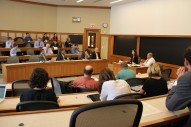Financing the Future of Energy Efficiency Summit
The Billion Dollar Green Challenge is a bold, even audacious, yet absolutely practical, common-sense approach for capitalizing investment in energy efficiency upgrades.
Witness the extraordinary gathering of participants at the Financing the Future of Energy Efficiency Summit at Harvard University on May 15. Attendees included chief financial officers, facilities directors, sustainability coordinators, foundation representatives, college faculty, college presidents, as well as people from the business world. What did they have in common?
 They came to the Summit because they understand that the single most important catalyst for implementing sustainability initiatives is to make the financial case for doing so. They came with a desire to better understand how to make green revolving funds work, not just to maximize the ubiquitous “ROI” (return on investment), but to integrate campus sustainability values with cutting-edge financial tools. Most importantly, participants joined regional and national colleagues, forming what will become a vibrant network of technical support and educational resilience.
They came to the Summit because they understand that the single most important catalyst for implementing sustainability initiatives is to make the financial case for doing so. They came with a desire to better understand how to make green revolving funds work, not just to maximize the ubiquitous “ROI” (return on investment), but to integrate campus sustainability values with cutting-edge financial tools. Most importantly, participants joined regional and national colleagues, forming what will become a vibrant network of technical support and educational resilience.
Although the trend towards green revolving funds is relatively recent, the Billion Dollar Green Challenge has already amassed a portfolio of best practices, case studies, and readily applicable models and scenarios for a range of institutional situations. The Summit presented a suite of hands-on workshops, catering to a just-in-time approach to implementation, from colleges that are taking their first steps in identifying and securing capital, to those that are researching the best practices in accounting and tracking performance, to colleges that aspire to innovate and expand their efforts with green revolving funds.
As I wandered through the various sessions, eavesdropped on hallway conversations, and listened to the questions, suggestions, and ideas, I felt both anticipation and accomplishment. The Billion Dollar Green Challenge is building much more than a consortium of financial capital tools. It’s coordinating a network of social and intellectual capital—ways for participants to merge expertise with aspiration, to invent and experiment, and to work with multiple campus constituencies.
 Five years ago when the American College and University Presidents’ Climate Commitment was launched, the biggest obstacle to the potential success of these programs was how they would be financed. Now higher education institutions know that creative and disciplined financial tools enable campuses to implement these initiatives as cost-saving approaches. Sustainability makes economic and ecological sense.
Five years ago when the American College and University Presidents’ Climate Commitment was launched, the biggest obstacle to the potential success of these programs was how they would be financed. Now higher education institutions know that creative and disciplined financial tools enable campuses to implement these initiatives as cost-saving approaches. Sustainability makes economic and ecological sense.
The Billion Dollar Green Challenge is still in its first year. The early-adopter Founding Circle and Charter Institutions will get a great head start. We should all be grateful for their willingness to take the lead with green revolving funds. What the Summit proved is that there is growing interest in this initiative. Campuses are financing sustainability breakthroughs that otherwise would never have been launched. Meanwhile, the importance of gathering and sharing data is crucial. Financial accountability demands a comprehensive approach.
Near the conclusion of the Summit, Felicia Davis of the United Negro College Fund’s Building Green Network made a compelling case that the Billion Dollar Green Challenge would only reach its full potential when its reach expanded to include minority serving institutions, community colleges, and other under-served constituencies. Our goals should be not only to raise one billion dollars of cumulative green revolving funds, but to make sure that access to such capital is possible for the widest-range of institutions.
The Billion Dollar Green Challenge intends to be comprehensive and inclusive, analytical and creative, accountable and accessible. That was clearly the spirit of the Summit, and reflects a uniquely compelling path to financing the future of energy efficiency.
Mitchell Thomashow
Director, Second Nature Presidential Fellows Program
Consultant, Billion Dollar Green Challenge
-
Subscribe
Subscribe via RSS -
Archives
- August 2023
- December 2019
- October 2019
- December 2018
- August 2018
- December 2017
- December 2016
- October 2016
- August 2016
- May 2016
- November 2015
- October 2015
- September 2015
- May 2015
- April 2015
- February 2015
- October 2014
- August 2014
- April 2014
- March 2014
- December 2013
- November 2013
- September 2013
- August 2013
- April 2013
- March 2013
- January 2013
- October 2012
- July 2012
- May 2012
- January 2012
- October 2011
